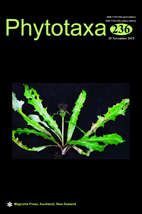Abstract
Vitaceae Juss. is a family of 15 genera and about 750 species mainly distributed in tropical regions of Asia, Africa, Australia, the neotropics, and the Pacific islands, with a few genera [Vitis Linnaeus (1753: 202), Parthenocissus Planchon [1887: 447(–448)], Ampelopsis Michaux (1803: 159), and Nekemias Rafinesque (1838: 87)] occurring in temperate regions (APGIII 2009, Wen 2007, Wen et al. 2014). The family is well known for its economical importance since several species, especially Vitis vinifera Linnaeus (1753: 202) and several artificial hybrids of Vitis, are important sources of grapes, wine, and raisins (Ardenghi et al. 2014). Bignonia peruviana Linnaeus (1753: 625), one of the 19 Vitaceae names published by Carl Linnaeus (see Jarvis 2007) appears to be yet untypified, and is here investigated as part of ongoing studies on: (1) Linnaean types (by D. Iamonico, see e.g., Ferrer-Gallego et al. 2014, Iamonico 2014a, 2014b, 2014c, Iamonico et al. 2014, 2015, Sukhorukov et al. 2014); (2) the genus Vitis in Italy (by N.M.G. Ardenghi, E. Banfi, and G. Galasso, see e.g. Ardenghi et al. 2014, 2015a, 2015b); (3) the Neotropical Vitaceae (by J. Lombardi, see e.g., Lombardi 1995, 1997, 2000, Rodrigues et al. 2014); and (4) the Bignoniaceae (by L.G. Lohmann, see e.g., Lohmann et al. 2013, Lohmann & Taylor 2014, Fonseca et al. 2015, Medeiros & Lohmann 2015, Zuntini et al. 2014).

